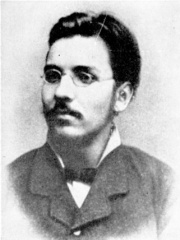


The Most Famous
CHEMISTS from Lithuania
Top 3
The following people are considered by Pantheon to be the most legendary Lithuanian Chemists of all time. This list of famous Lithuanian Chemists is sorted by HPI (Historical Popularity Index), a metric that aggregates information on a biography's online popularity.

1. Wilfrid Voynich (1865 - 1930)
With an HPI of 72.15, Wilfrid Voynich is the most famous Lithuanian Chemist. His biography has been translated into 36 different languages on wikipedia.
Wilfrid Voynich (born Michał Habdank-Wojnicz; 12 November [O.S. 31 October] 1865 – 19 March 1930) was a Polish revolutionary, antiquarian and bibliophile. Voynich operated one of the largest rare book businesses in the world. He is remembered as the eponym of the Voynich manuscript.

2. Aaron Klug (1926 - 2018)
With an HPI of 70.28, Aaron Klug is the 2nd most famous Lithuanian Chemist. His biography has been translated into 60 different languages.
Sir Aaron Klug (11 August 1926 – 20 November 2018) was a British biophysicist and chemist. He was a winner of the 1982 Nobel Prize in Chemistry for his development of crystallographic electron microscopy and his structural elucidation of biologically important nucleic acid-protein complexes.

3. Phoebus Levene (1869 - 1940)
With an HPI of 57.37, Phoebus Levene is the 3rd most famous Lithuanian Chemist. His biography has been translated into 20 different languages.
Phoebus Aaron Theodore Levene (25 February 1869 – 6 September 1940) was a Russian-born American biochemist who studied the structure and function of nucleic acids. He characterized the different forms of nucleic acid, DNA from RNA, and found that DNA contained adenine, guanine, thymine, cytosine, deoxyribose, and a phosphate group. He was born into a Litvak (Lithuanian Jewish) family as Fishel Aronovich Levin in the town of Žagarė in Lithuania, then part of the Russian Empire, but grew up in St. Petersburg. There he studied medicine at the Imperial Military Medical Academy (M.D., 1891) and developed an interest in biochemistry. In 1893, because of antisemitic pogroms, he and his family emigrated to the United States and he practiced medicine in New York City. Levene enrolled at Columbia University and in his spare time conducted biochemical research, publishing papers on the chemical structure of sugars. In 1896 he was appointed as an Associate in the Pathological Institute of the New York State Hospitals, but he had to take time off to recuperate from tuberculosis. During this period, he worked with several chemists, including Albrecht Kossel and Emil Fischer, who were the experts in proteins. In 1905, Levene was appointed as head of the biochemical laboratory at the Rockefeller Institute of Medical Research. He spent the rest of his career at this institute, and it was there that he identified the components of DNA. In 1909, Levene and Walter Jacobs recognised d-ribose as a natural product and an essential component of nucleic acids. They also recognised that the unnatural sugar that Emil Fischer and Oscar Piloty had reported in 1891 was the enantiomer of d-ribose. Levene went on to discover deoxyribose in 1929. Not only did Levene identify the components of DNA, he also showed that the components were linked together in the order phosphate-sugar-base to form units. He called each of these units a nucleotide, and stated that the DNA molecule consisted of a string of nucleotide units linked together through the phosphate groups, which are the 'backbone' of the molecule. His ideas about the structure of DNA were wrong; he thought there were only four nucleotides per molecule. He even declared that it could not store the genetic code because it was chemically far too simple. However, his work was a key basis for the later work that determined the structure of DNA. Levene published over 700 original papers and articles on biochemical structures. Levene died in 1940, before the true significance of DNA became clear. Levene is known for his tetranucleotide hypothesis which proposed that DNA was made up of equal amounts of adenine, guanine, cytosine, and thymine. Before the later work of Erwin Chargaff, it was widely thought that DNA was organized into repeating tetranucleotides in a way that could not carry genetic information. Instead, the protein component of chromosomes was thought to be the basis of heredity; most research on the physical nature of the gene focused on proteins, and particularly enzymes and viruses, before the 1940s. Levene was an elected member of both the United States National Academy of Sciences and the American Philosophical Society.
People
Pantheon has 3 people classified as Lithuanian chemists born between 1865 and 1926. Of these 3, none of them are still alive today. The most famous deceased Lithuanian chemists include Wilfrid Voynich, Aaron Klug, and Phoebus Levene.
Deceased Lithuanian Chemists
Go to all RankingsWilfrid Voynich
1865 - 1930
HPI: 72.15
Aaron Klug
1926 - 2018
HPI: 70.28
Phoebus Levene
1869 - 1940
HPI: 57.37
Overlapping Lives
Which Chemists were alive at the same time? This visualization shows the lifespans of the 3 most globally memorable Chemists since 1700.

